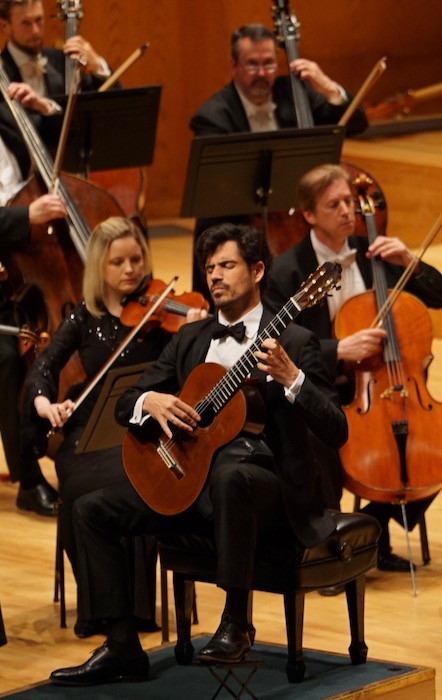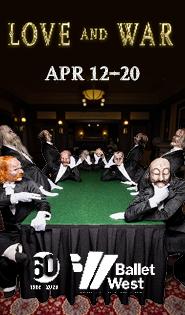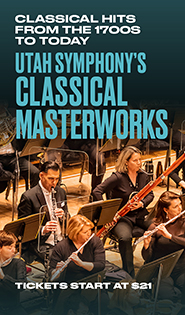Guitarist Villegas shines in wide-ranging program from Utah Symphony

Guitarist Pablo Sáinz Villegas was the soloist with the Utah Symphony Friday night at Abravanel Hall. Photo: Kathleen Sykes
In the comparatively small world of virtuoso classical guitarists — compared to pianists and violinists — Pablo Sáinz Villegas ranks at the top for his mastery of the instrument, technical chops and consummate musicality.
The Spanish guitarist is this weekend’s guest artist with the Utah Symphony, and at Friday’s concert in Abravanel Hall he put his artistry on full display in a magnificent performance of Joaquin Rodrigo’s Concierto de Aranjuez.
Rodrigo’s neo-classical concerto is without question one of the most popular works of for guitar, its famous Adagio a proverbial Top 40 favorite. On Friday, Villegas gave a memorable account of the Adagio that captured the music’s poignancy and depth of expression. He brought subtlety and nuanced lyricism to playing that was mirrored by Lissa Stolz’s captivating English horn solos.
And guest conductor Richard Egarr’s stately tempo underscored the delicacy of the music. The guitar cadenza that rather unexpectedly flows out of this elegantly crafted music is robustly virtuosic, and the soloist acquitted himself wonderfully with his bravura playing.
In the outer movements, Villegas and Egarr captured the lightness and intimacy of the music with their balanced and well crafted collaboration that allowed the finely woven interplay between soloist and ensemble to shine. Both movements were also rhythmically fluid and infused with nuanced expressiveness.
Villegas rewarded the audience’s enthusiastic applause with two encores by Francisco Tárrega: the showstopping Gran Jota, its unbridled energy underscored by Villegas’s virtuosic playing; and the lovely Recuerdos de la Alhambra, a dreamy, atmospheric side of the composer whose fluid lyricism Villegas interpreted with thoughtful sensitivity.
The concert opened with Mozart’s Symphony No. 31, “Paris.” Egarr’s animated conducting style was perfectly suited for the piece as he led the orchestra through a crisp, precisely articulated reading of this early Mozart work. Egarr’s background in baroque and classical repertoire allowed him to elicit a finely balanced account that brought out the exuberance of the opening movement, the seamless expressiveness of the second and the invigorating burst of energy in the closing third movement.
The English conductor’s brisk tempi let the bright, airy nature of the work come through with clarity. To his credit, Egarr didn’t go for effect — and there is plenty of that in this work, with its abrupt changes in dynamics and sudden crescendi. Instead, his interpretation, while at times bold, was wonderfully musical and cohesive in and across the movements.
The evening ended with Schumann’s optimistic Symphony No. 2. Egarr attacked the youthful enthusiasm of the work’s first movement with an almost Schubertian ebullience that served it well, his broad gestures coaxing dynamic vitality and powerful, expressive phrasing from the orchestra.
That carried over into the second movement scherzo, whose high spirits Egarr captured with his sprightly tempo and the vivacious playing he elicited. In the slower passages, Egarr’s tempo enabled a perceptive and nuanced reading that brought out the music’s subtle lyricism. Here, the orchestra played with emotive finesse and craft.
The finale returned to the first movement’s cheery character, and Egarr’s large gestures underscored the music’s restless drive — well articulated by the ensemble’s clean-lined playing.
The program will be repeated 7:30 p.m. Saturday in Abravanel Hall. utahsymphony.org; 801-355-2787.

